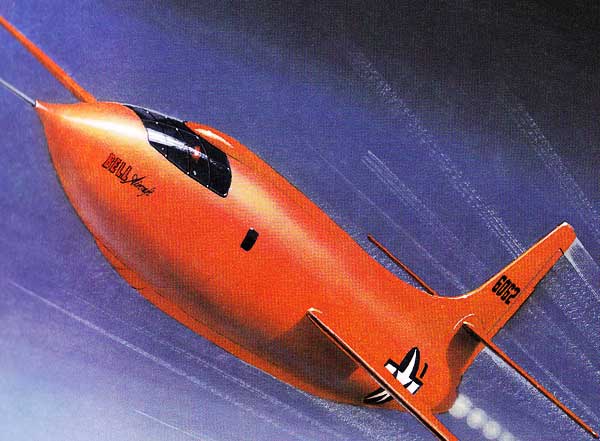The First Supersonic Controlled Flight - X Planes
The first recognized flight exceeding the speed of sound for the first time by a manned aircraft in controlled level flight was on October 14, 1947 in an American research project, using the experimental Bell X-1 research rocket plane, piloted by Charles "Chuck" Yeager.
The Bell X-1 was a joint NACA-U.S. Army Air Forces-U.S. Air Force supersonic research project built by the Bell Aircraft Company. The X-1 was the first airplane to exceed the speed of sound in level flight and was the first of the so-called X-planes, a series of American experimental rocket planes designated for testing of new technologies and often kept secret.

On 16 March 1945, the U.S. Army Air Forces Flight Test Division and the National Advisory Committee for Aeronautics (NACA) made a contract with the Bell Aircraft Company to build three X-1 aircraft to obtain flight data on conditions in the transonic speed range. its shape closely resembling a Browning .50-caliber machine gun bullet, known to be stable in supersonic flight. The pattern shape was followed to the point of seating its pilot behind a sloped, framed window inside a confined cockpit in the nose, with no ejection seat. The rocket propulsion system was a four-chamber engine built by Reaction Motors, Inc., one of the first companies to build liquid-propellant rocket engines in America.
The Army Air Forces was unhappy with the cautious pace of flight envelope expansion and Bell Aircraft's flight test contract for airplane was terminated. The test program was taken over by the Army Air Force Flight Test Division on 24 June after months of negotiation. Goodlin had demanded a US$150,000 bonus for breaking the sound barrier. Flight tests of the X-1-2 would be conducted by NACA to provide design data for later production high-performance aircraft.
On 14 October 1947, just under a month after the U.S. Air Force had been created as a separate service, the tests reached their peak with the first manned supersonic flight, piloted by Air Force Captain Charles "Chuck" Yeager in aircraft that he had christened the Glamorous Glennis for his wife. This rocket-powered airplane was drop launched from the bomb bay of a modified B-29 Superfortress bomber, and it glided to a landing on the dry lake bed. XS-1 flight number 50 is the first one in which the X-1 recorded supersonic flight, at Mach 1.06 (313 m/s, 1,126 km/h, 800 mph) peak speed.
On 14 October 1947, just under a month after the U.S. Air Force had been created as a separate service, the tests reached their peak with the first manned supersonic flight, piloted by Air Force Captain Charles "Chuck" Yeager in aircraft that he had christened the Glamorous Glennis for his wife. This rocket-powered airplane was drop launched from the bomb bay of a modified B-29 Superfortress bomber, and it glided to a landing on the dry lake bed. XS-1 flight number 50 is the first one in which the X-1 recorded supersonic flight, at Mach 1.06 (313 m/s, 1,126 km/h, 800 mph) peak speed.
As a result of the X-1's initial supersonic flight, the National Aeronautics Association voted its 1948 Collier Trophy to be shared by the three main participants in the program. Honored at the White House by President Harry S. Truman were Larry Bell for Bell Aircraft, Captain Yeager for piloting the flights, and John Stack for the contributions of the NACA.
The story of Yeager’s 14 October flight was leaked to a reporter from Aviation Week, and The Los Angeles Times featured the story as headline news in their 22 December issue. The magazine story was released 20 December. The Air Force threatened legal action against the journalists who revealed the story, but none was ever taken.
On 5 January 1949, Yeager used Aircraft to carry out the only conventional (runway) take off performed during the X-1 program, reaching 23,000 ft (7,000 m) in 90 seconds.

